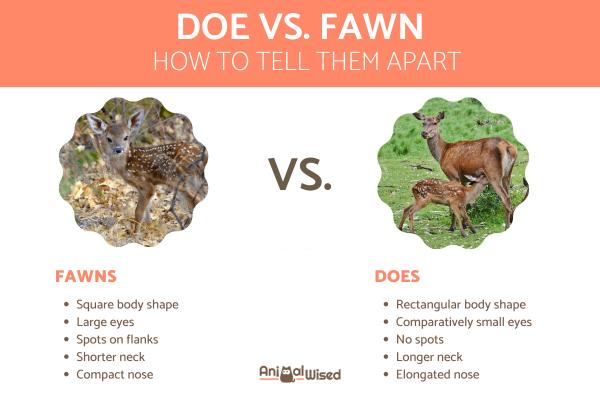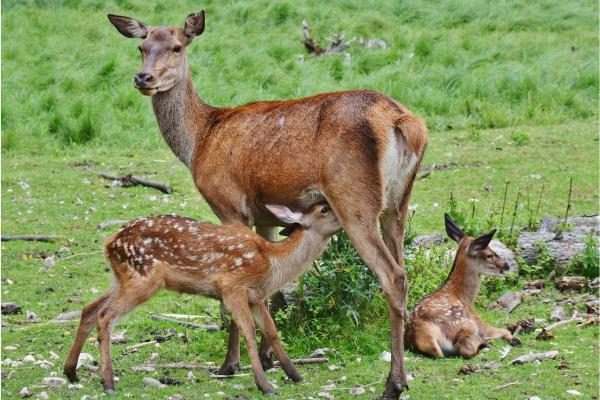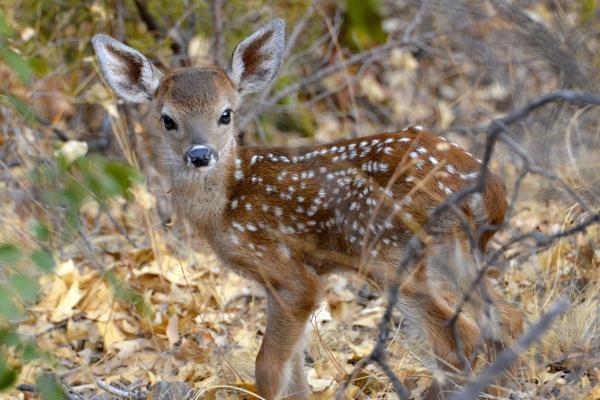
The difference between a fawn and a doe deer is to do with age and sex, not with breed. Different types of deer live in different regions, but we use the same terminology for the ages and sex of all true deer species. Many people want to know the difference between the two for hunting purposes, but this information is useful for rambling, orienteering or simply to know more about these wonderful animals. If you are out on a country walk where deer are known to live, you may want to know how to tell the difference between a doe and a fawn.
At AnimalWised, we make this doe vs. fawn deer comparison so can know the difference between the two. We also explain some of the different terminologies
Why is it important to know the difference between a doe and a fawn?
One of the main reasons people want to make a doe vs. fawn comparison is to do with hunting. Deer hunting is both a sport and a means of conservation in some areas. This is because deer populations in some areas strip vegetation and their numbers need to be culled. This is an indirect result of many of the apex predator populations being reduced in various ecosystems.
Deer hunting in places like the United States and United Kingdom requires a license. This allows you to hunt deer, but it does not give you free reign to kill as many deer as you like. To protect deer populations, a ‘bag limit’ will be in place which determines how many deer you are allowed to kill. This will also include the type of deer you are allowed to kill.
For example, you are allowed to kill up to 5 deer in the state of Florida[1]. However, of these 5 total, only 2 are allowed to be antlerless. Both does and fawns will not have antlers, except in rare occasions which we will explain below. Knowing the difference helps hunters know which deer they should target, although they need to take into consideration antler shedding.
While we do not encourage hunting of any kind, it is important to follow hunting guidelines to protect deer populations in general. This is one reason for hunting seasons. If a hunter was to kill a mother deer which has not yet weaned her young, then these juvenile deer may be left helpless and die. For this reason, a hunting season should only begin once the young are fully weaned and able to fend for themselves.
Knowing the difference between a doe and a fawn can help management objectives for conservationists. It also can allow fawns to develop into stags, something which may be useful for a given group of deer.
What is a doe?
The term ‘doe’ is a reference to the sex of a deer. Specifically, a doe is a female deer. This is in comparison to a fully grown male deer which is usually known as a stag. Once they are adult, we can tell the difference between a male and female deer by two factors. Firstly, a stag will be much larger than a doe. Secondly, stags have antlers for most of the year, while does do not.
In very rare occasions, a doe may have antlers. If we were ever to see a doe with antlers, they would usually be temporary and fall off after they become pregnant. These antlers will not be as large or strong as stag antlers and they would not be used for fighting. This can vary according to species as female reindeer are more likely than most other species to have antlers, although this is still uncommon.
Although does are smaller than stags, they can still reach a large size. True deer are all members of the family Cervidae. This includes the largest and smallest species of Cervidae which are the moose (Alces alces) and the northern pudu (Pudu mephistophiles), respectively. The female pudu does not usually grow much heavier than 13 lb, but female moose can weigh over a ton. What deer are near you depends on where different deer live.
However, not all female deer are commonly known as does. For example, a female moose is much more commonly known as a cow and the male a bull. Deer species which have females known as does include:
- Roe deer (Capreolus capreolus)
- Mule deer (Odocoileus hemionus)
- European fallow deer (Dama dama)
- White-tailed deer (Odocoileus virginianus)
Some female deer species use different terminology. We have already mentioned that female moose are called cows, but a female red deer (Cervus elaphus) are more commonly known as a hind.
Learn more about the different animals from the family Cervidae with our guide to the different types of deer.

What is a fawn?
The fawn is the young of the ruminant animal known as deer, but not always. Generally speaking, the young of a large deer species is known as a ‘calf’ and only the young of the smaller deer species are known as ‘fawns’. This correlates the same as does. The species listed above which have females known as does will have young called fawns. Larger species such as red deer, moose and reindeer have calves.
There are also different terminologies for fawns. For example, all male deer are also known as bucks, but it is only usually applied to juvenile male deer after they become younglings. This is the case with button bucks. These are male deer whose antlers have not developed, but they may have small bumps on their head where the antlers start to grow in.
Fawns of most deer species will have spots on their coat, although there may be exceptions. For most deer in North America, the fawns will have spots. Contrary to what some believe, you cannot tell the sex of a fawn from their spots. These patterns are different for every individual, similar to fingerprints.
Generally speaking, a young deer is known as a fawn until they are a year old. After this time they are known as yearlings, regardless if they are male or female. After this time, they will be known as stags or does, depending on their sex.

How to tell a doe vs. fawn
Although we can usually tell the difference between a doe and a fawn thanks to size, this is not always reliable. For example, a large male fawn (usually a button buck) can be almost the same size as a small adult doe. At this stage, the fawn will have lost their spots, making it more difficult. We can also tell by the fact that fawns have their milk teeth, but this is not something we can determine when we see them in the wild.
For this reason, we can make a doe vs. fawn comparison using the following:
- Shape: a fawn's body is about as long as it is tall, meaning they are square shaped. Adult does are longer than they are tall, meaning they are more rectangular.
- Spots: if we see spots on the deer's coat, it means they are a young fawn. Adult deer do not have spots, but neither do yearlings.
- Neck: the necks of fawns are shorter than their adult counterparts, whether male or female.
- Nose: similar to their necks, fawns have a more compact nose while does' noses are elongated.
- Eyes: young deer have eyes which sit relatively large in their heads. Adult does have larger eyes, but they are comparatively smaller with the rest of their face.
- Group: if we see deer in a group, they will almost always be females with their young since stags and button bucks travel alone. When we see this group, the doe will be larger.
As you can see, it can be difficult to differentiate between a doe vs. fawn. This is because the features we need to look at are difficult to determine if they are moving or far away. However, using this comparison, you should be able to know a doe from a fawn.

If you want to read similar articles to Doe vs. Fawn Deer Comparison, we recommend you visit our Facts about the animal kingdom category.
1. Florida Fish and Wildlife Conservation Commission. (n.d.). FAQs About Deer Hunting Rules. Retrieved from:
https://myfwc.com/hunting/deer/faqs/